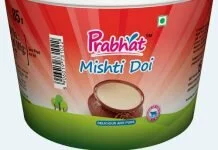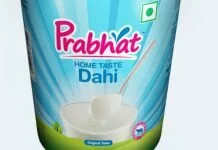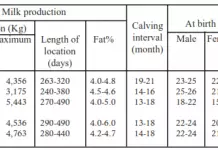Milk powder manufacture is a simple process now carried out on a large scale.
It involves the gentle removal of water at the lowest possible cost under stringent hygiene conditions while retaining all the desirable natural properties of the milk – colour, flavour, solubility,nutritional value. Whole (full cream) milk contains, typically, about 87% water and skim milk contains about 91% water. During milk powder manufacture, this water is removed by boiling the milk under reduced pressure at low temperature in a process known as evaporation. The resulting concentrated milk is then sprayed in a fine mist into hot air to remove further moisture and so give a powder. Approximately 13 kg of whole milk powder (WMP) or 9 kg of skim milk powder (SMP) can be made from 100 L of whole milk.
New Zealand manufactures a wide range of spray dried milk powders (> 100) to meet the diverse and special needs of customers. Milk powders may vary in their gross composition (milkfat, protein, lactose), the heat treatment they receive during manufacture, powder particle size and packaging. Special “high heat” or “heat-stable” milk powders are required for the manufacture of certain products such as recombined evaporated milk. Milk powders of various types are used in a wide range of products such as baked goods, snacks and soups, chocolates and confectionary (e.g. milk chocolate), ice cream, infant formulae, nutritional products for invalids, athletes, hospital use etc., recombined milks and other liquid beverages.
A glossary of terms is given on the last page of this article.
INTRODUCTION
Marco Polo in the 13th century reported that soldiers of Kublai Khan carried sun-dried milk on their expeditions. In more recent times, milk has been dried in thin films on heated rollers. The earliest patents for this process date from the turn of the century. Such roller drying was the main means of producing milk powders until the 1960s when spray drying took over. Milk powder manufacture is now very big business.
New Zealand produced and exported over 450 000 tonnes of milk powder during the 1993/94 dairying season, earning in excess of NZ$1 billion. Milk powder manufacture is a simple process now carried out on a large scale. It involves the gentle removal of water at the lowest possible cost under stringent hygiene conditions while retaining all the desirable natural properties of the milk – colour, flavour, solubility, nutritional value. Whole (full cream) milk contains, typically, about 87% water and skim milk contains about 91% water.
During milk powder manufacture this water is removed by boiling the milk under reduced pressure at low temperature in a process known as evaporation. The resulting concentrated milk is then sprayed in a fine mist into hot air to remove further moisture and so give a powder. Approximately 13 kg of whole milk powder (WMP) or 9 kg of skim milk powder (SMP) can be made from 100 L of whole milk. The milk powder manufacturing process is shown in the following schematic and is described in detail below :
SEPARATION / STANDARDIZATION
The conventional process for the production of milk powders starts with taking the raw milk received at the dairy factory and pasteurizing and separating it into skim milk and cream using a centrifugal cream separator. If WMP is to be manufactured, a portion of the cream is added back to the skim milk to produce a milk with a standardized fat content (typically 26-30% fat in the powder). Surplus cream is used to make butter or anhydrous milkfat.
PREHEATING
The next step in the process is “preheating” during which the standardised milk is heated to temperatures between 75 and 120C and held for a specified time from a few seconds up to several minutes (cf. pasteurisation: 72C for 15 s). Preheating causes a controlled denaturation of the whey proteins in the milk and it destroys bacteria, inactivates enzymes, generates natural antioxidants and imparts heat stability. The exact heating/holding regime depends on the type of product and its intended end-use. High preheats in WMP are associated with improved keeping quality but reduced solubility. Preheating may be either indirect (via heat exchangers), or direct (via steam injection or infusion into the product), or a mixture of the two. Indirect heaters generally use waste heat from other parts of the process as an energy saving measure.
EVAPORATION
In the evaporator the preheated milk is concentrated in stages or “effects” from around 9.0% total solids content for skim milk and 13% for whole milk, up to 45-52% total solids. This is achieved by boiling the milk under a vacuum at temperatures below 72C in a falling film on the inside of vertical tubes, and removing the water as vapour.
This vapour, which may be mechanically or thermally compressed, is then used to heat the milk in the next effect of the evaporator which may be operated at a lower pressure and temperature than the preceding effect. Modern plants may have up to seven effects for maximum energy efficiency. More than 85% of the water in the milk may be removed in the evaporator. Evaporators are extremely noisy because of the large quantity of water vapour travelling at very high speeds inside the tubes.
SPRAY DRYING
Spray drying involves atomising the milk concentrate from the evaporator into fine droplets. This is done inside a large drying chamber in a flow of hot air (up to 200C) using either a spinning disk atomiser or a series of high pressure nozzles. The milk droplets are cooled by evaporation and they never reach the temperature of the air.
The concentrate may be heated prior to atomisation to reduce its viscosity and to increase the energy available for drying. Much of the remaining water is evaporated in the drying chamber, leaving a fine powder of around 6% moisture content with a mean particle size typically of
PACKAGING AND STORAGE
Milk powders are immensely more stable than fresh milk but protection from moisture, oxygen, light and heat is needed in order to maintain their quality and shelf life. Milk powders readily take up moisture from the air, leading to a rapid loss of quality and caking or lumping. The fat in WMPs can react with oxygen in the air to give off-flavours, especially at higher storage temperatures (> 30C) typical of the tropics. Milk powder is packed into either plastic-lined multi-wall bags (25 kg) or bulk bins ( 600 kg).
WMPs are often packed under nitrogen gas to protect the product from oxidation and to maintain their flavour and extend their keeping quality. Packaging is chosen to provide a barrier to moisture, oxygen and light. Bags generally consist of several layers to provide strength and the necessary barrier properties. Shipments of milk powder should never suffer prolonged exposure to direct sunshine especially in tropical countries. A few hours at elevated temperatures (> 40C) during transshipment can negate many weeks of careful storage.
AGGLOMERATED POWDERS
Standard powders, because of their fine dusty nature, do not reconstitute well in water. “Agglomerated” and “instant” powders were specifically developed to counter this. The manufacture of an agglomerated powder initially follows the standard process of evaporation and drying, described above. However, during spray drying small particles of powder leaving the drier (the “fines”) are recovered in cyclones and returned to the drying chamber in the close proximity of the atomiser. The wet concentrate droplets collide with the fines and stick together, forming larger (0.1-0.3 mm), irregular shaped “agglomerates”. Agglomerated powders disperse in water more rapidly and are less dusty and easier to handle than standard powders.
INSTANT WHOLE MILK POWDER
With WMP, an extra step is required after agglomeration to make the product truly “instant” and overcome the hydrophobic (water-hating) nature of traces of free fat on the surface of the particles. This extra step consists of spraying minute quantities of the natural surfactant or wetting agent, soy lecithin, on to the powder in a fluid bed. Soy lecithin is extracted from soy bean oil. Lecithins are widespread in nature and they occur naturally in milk.
ENERGY AND ENVIRONMENTAL CONSIDERATIONS
Large amounts of energy are expended in the process of removing water and so plants developed over the years have become increasingly more energy efficient. Evaporators are much more energy efficient than driers, using only a fraction of a kilogram of steam (or the energy equivalent) per kilogram of water removed. Driers on the other hand use several kilograms of steam (or steam equivalent) per kilogram of water evaporated. Spray drying provides a means of rapidly and gently removing the bulk of the remaining water but, ideally, spray driers have short residence times.
Hence fluid beds are used for the final stages of drying. The powder remains for several minutes in fluid beds allowing time for the last of the water to be removed. Milk powder manufacturing plants tend to be very large, few in number and located in rural areas. If modern and well managed, they have only relatively small effects on the environment. They are moderately energy intensive, burning coal or gas and consuming substantial electricity. There are strong economic pressures to reduce energy consumption but there is little scope for further major improvement. Milk storage silos, cream separators and the evaporators and associated plant must be cleaned daily, and driers less often. Sodium hydroxide and nitric acid are used as cleaning agents.
The spent cleaning fluids must be disposed of by suitable means. There can be emission of milk powder dust into the local environment during plant malfunctions but this is rare. Noise is a problem mainly within the plant buildings but fans can affect close neighbours. Unbleached paper and plastic laminate packaging must be disposed of in overseas markets.
LOCATION OF MANUFACTURING PLANTS
In New Zealand there are milk powder plants at: Dargaville, Maungaturoto and Kauri in Northland (Northland Co-op); Te Rapa, Morrinsville, Waitoa, and Te Awamutu in the Waikato (New Zealand Dairy Group); Whareroa in Taranaki (Kiwi Co-op Dairies); Pahiatua and Longburn in the Manawatu (Kiwi Co-op Dairies); Brightwater near Nelson (Tasman Milk Products); Hokitika in Westland (Westland Co-op); Christchurch (Plains Co-op); Clandeboye, in Canterbury (Alpine Dairy Products); and Edendale in Southland (Southland Dairy Co-op). The combined plants are capable of processing about 25 milliom litres of milk per day.
APPLICATIONS
New Zealand manufactures a wide range of spray dried milk powders (> 100) to meet the diverse and special needs of customers. Milk powders may vary in their gross composition (milkfat, protein, lactose), the heat treatment they receive during manufacture, powder particle size and packaging. Special “high heat” or “heat stable” milk powders are required for the manufacture of certain products such as recombined evaporated milk. Some powders are agglomerated and they may be instantised for easy use in the home. Instant powders must
wet, sink and disperse quickly, with minimal stirring, when added to water. The resulting liquid should closely resemble fresh milk and be free from undissolved particles. Some powders are fortified with vitamins and minerals. It is very important to use a powder suited to the intended application. Milk powders of various types are used in a wide range of products including the following.
- Baked goods, snacks and soups
- Cheese milk extension (powder is added to local fresh milk to increase the yield of
cheese) - Chocolates and confectionery (e.g. milk chocolate)
- Dairy desserts
- Direct consumer use (home reconstitution)
- Ice cream
- Infant formulae
- Nutritional products for invalids, athletes, hospital use etc.
- Recombined “fresh”, UHT, evaporated and sweetened condensed milks
- Recombined cheeses, mainly “soft” or “fresh”
- Recombined coffee and whipping creams
Recombined yogurts and other fermented products
SELECTED DEFINITIONS
Atomiser A device for producing fine droplets of liquid. Usually either a high pressure nozzle or a perforated spinning disk through which the liquid is pumped.
Concentrate Milk concentrated by evaporation, typically containing around 48% total solids.
Cyclone A device for separating air and powder particles.
Effect A single unit in an evaporator operating at a particular pressure and temperature. Evaporators commonly have three to seven effects to allow heat to be reused several times.
Fluid bed A piece of equipment used for drying or cooling milk powder. Air is blown through the powder from below, causing the powder particles to separate and behave rather like a fluid. Alternatively, a layer of fluid-like powder in which the particles are kept apart by an air flow.
Recombined Liquid milk or other “fresh” product made by mixing skim milk powder, milkfat, water and possibly other components.
Reconstituted Liquid milk or other “fresh” product made by mixing milk powder and water.
Written by Dr. K. N. Pearce (Food Science Section, New Zealand Dairy Research Institute).



















